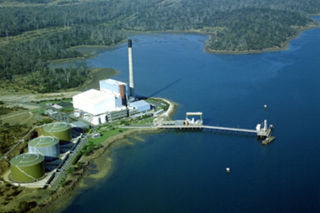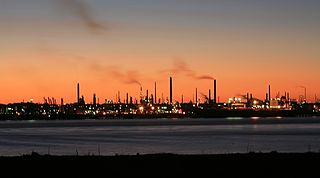
Peaking power plants, also known as peaker plants, and occasionally just "peakers", are power plants that generally run only when there is a high demand, known as peak demand, for electricity. Because they supply power only occasionally, the power supplied commands a much higher price per kilowatt hour than base load power. Peak load power plants are dispatched in combination with base load power plants, which supply a dependable and consistent amount of electricity, to meet the minimum demand.
The East–West Interconnector is a 500 MW high-voltage direct current submarine and subsoil power cable which connects the Irish and British electricity markets. The project was developed by the Irish national grid operator EirGrid.

The Bell Bay Power Station was a power station located in Bell Bay, on the Tamar River, Tasmania, Australia, adjacent to the Tamar Valley Power Station, with which it was often confused. It was commissioned between 1971 and 1974 as an oil fired thermal power station, and was converted to natural gas in 2003, after the commissioning of the Tasmanian Gas Pipeline, a submarine gas pipeline which transports natural gas from Longford, Victoria, under Bass Strait, to Bell Bay, Tasmania. As the power station's primary role was to provide system security in the event of drought for Tasmania's predominantly hydro-electric based generation system it only was rarely called on to operate, resulting in intervals of five to eight years between periods of significant use. After the commissioning of Basslink in 2006, the power station was decommissioned in 2009.
FortisBC is a Canadian owned, British Columbia based regulated utility focused on providing safe and reliable energy, including natural gas, Renewable Natural Gas, electricity and propane. FortisBC has approximately 2,600 employees serving more than 1.2 million customers in 135 B.C. communities and 58 First Nations communities across 150 Traditional Territories.

Coryton Refinery was an oil refinery in Essex, England, on the estuary of the River Thames 28 miles (45 km) from central London, between Shell Haven Creek and Hole Haven Creek, which separates Canvey Island from the mainland.

Energy consumption across Russia in 2020 was 7,863 TWh. Russia is a leading global exporter of oil and natural gas and is the fourth highest greenhouse emitter in the world. As of September 2019, Russia adopted the Paris Agreement In 2020, CO2 emissions per capita were 11.2 tCO2.

Fawley Refinery is an oil refinery located at Fawley, Hampshire, England. The refinery is owned by Esso Petroleum Company Limited, a subsidiary of Exxon Mobil Corporation, which acquired the site in 1925. Situated on Southampton Water, it was rebuilt and extended in 1951 and is now the largest oil refinery in the United Kingdom, and one of the most complex refineries in Europe. With a capacity of 270,000 barrels (43,000 m3) per day, Fawley provides 20 percent of the UK's refinery capacity. An estimated 1000 people are employed at the site.

Queensland's energy policy is based on the year 2000 document called the Queensland Energy Policy: A Cleaner Energy Strategy. The Queensland Government assists energy development through the Department of Energy and Water Supply. The state is noted for its significant contribution to coal mining in Australia. The primary fuel for electricity generation in the state is coal with coal seam gas becoming a significant fuel source. Queensland has 98% of Australia's reserves of coal seam gas. An expansion of energy-intensive industries such as mining, economic growth and population growth have created increased demand for energy in Queensland.
Natural gas was Canada's third largest source of energy production in 2018, representing 22.3% of all energy produced from fuels in the country. By contrast, the share of fuel-based energy production from natural gas in 2013 was 17.0%, indicating a growth rate of approximately 1.06% per year.
The United Kingdom's National Transmission System (NTS) is the network of gas pipelines that supply gas to about forty power stations and large industrial users from natural gas terminals situated on the coast, and to gas distribution companies that supply commercial and domestic users. It covers Great Britain, i.e. England, Wales and Scotland.

Ireland is a net energy importer. Ireland's import dependency decreased to 85% in 2014. The cost of all energy imports to Ireland was approximately €5.7 billion, down from €6.5 billion (revised) in 2013 due mainly to falling oil and, to a lesser extent, gas import prices. Consumption of all fuels fell in 2014 with the exception of peat, renewables and non-renewable wastes.
Shetland HVDC Connection is a high-voltage direct current submarine power cable under construction to connect Shetland to the British mainland.

La Collette Power Station is the main power station for Jersey, and is now the main control centre for the Channel Islands Electricity Grid. It is operated by Jersey Electricity (JE). Under normal circumstances the power generation facilities served as an emergency supply in case of power interruption, however the failure of undersea cables in 2012 temporarily returned La Collette's role to full-time generation.

This article describes energy and electricity production, consumption, import and export in Kenya. Kenya's current effective installed electricity capacity is 2,651 MW, with peak demand of 1,912 MW, as of November 2019. At that time, demand was rising at a calculated rate of 3.6 percent annually, given that peak demand was 1,770 MW, at the beginning of 2018. Electricity supply is mostly generated by renewable sources with the majority coming from geothermal power and hydroelectricity.

The main power supply for Shetland is provided by Lerwick Power Station, located in Gremista, 2 kilometres (1.2 mi) northwest of Lerwick town centre. This is the principal source of electrical energy for Shetland, however currently about 20 MWe is provided by the Sullom Voe Terminal power station which comprises 4 x 23 MWe Gas Turbines, the future of which is uncertain. Opened on 27 May 1953 the station is diesel-fuelled and generates a total of 66 MW of power.
Grain LNG Terminal is a Liquefied Natural Gas (LNG) terminal on the Isle of Grain, 37 miles (60 km) east of London. It has facilities for the offloading and reloading of LNG from ships at two jetties on the River Medway; for storing and blending LNG; for truck loading; and regasifying and blending natural gas to meet UK specifications. The terminal can handle up to 15 million tonnes per annum of LNG, has storage capacity for one million cubic metres of LNG, and is able to regasify up to 645 GWh per day for delivery into the high pressure gas National Transmission System (NTS). The facility is owned and operated by National Grid Grain LNG Ltd, a wholly owned subsidiary of National Grid.
Bermuda Electric Light Company Limited (BELCO) is a Bermudian electricity-generating company. It is the country's sole supplier of electricity, operating a generating plant. transmission and distribution systems throughout the territory. It is a subsidiary of Ascendant Group Limited, together with Bermuda Gas, PureNERGY Renewables, and inVenture Limited.
Tüpraş Kırıkkale Oil Refinery is an oil refinery in Kırıkkale, central Turkey. It is owned and operated by Tüpraş, the country's only oil refiner with four refineries.
The Sapugaskanda Refinery is the single largest oil refinery of Sri Lanka. The refinery was built by Iran under the guidance of the Ceylon Petroleum Corporation in August 1969, initially designed to process 38,000 barrels (6,000 m3) per stream day of Dubai crude oil, and Arabian light crude oil. It was commissioned on 12 October 1969. The facility, which covers an area of 165 acres (67 ha), currently has a capacity of 50,000 barrels (7,900 m3) per stream day.
The Western Isles HVDC connection is a proposed 1.8GW HVDC submarine power cable to connect the Isle of Lewis to the Scottish mainland.










